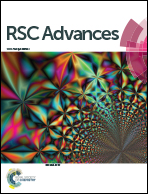Native honeybee silk membrane: a potential matrix for tissue engineering and regenerative medicine
Abstract
Biomimetic natural origin biomaterials are noteworthy targets for further innovation in biomedical and tissue engineering. In this study, honeybee silk membranes (HBSM) are investigated in their native form to explore their applicability for tissue engineering. HBSMs extracted from honeybee combs were physico-chemically characterized for their surface topography, stability followed by evaluation of the biodegradation, mechanical and biological properties. Field emission scanning electron microscopy (FESEM) and atomic force microscopy (AFM) studies revealed a uniform sheet-like morphology with sub-micron pores and the presence of evenly knitted fibers in a specific pattern/alignment. Fourier transform infrared (FTIR) spectroscopy suggested the presence of a native coiled coil structural conformation. HBSMs were found to be cytocompatible and supported the proliferation of murine L929 fibroblasts, human osteosarcoma MG-63 cells and primary porcine knee chondrocytes. Cells cultured on HBSMs maintained osteogenic and chondrogenic potential as indicated by mineralization and accumulation of sulphated glycosaminoglycans (GAGs), respectively. In vitro analysis of the immune response (in terms of TNF-α release) and blood compatibility (in terms of LDH activity) further attests its possible applicability. Moreover, an in vivo subcutaneous implantation study in mice showed minimal inflammation. Taken together, this study demonstrates the potential of natural, biocompatible HBSMs as a suitable biomaterial for tissue engineering and regenerative medicine.


 Please wait while we load your content...
Please wait while we load your content...